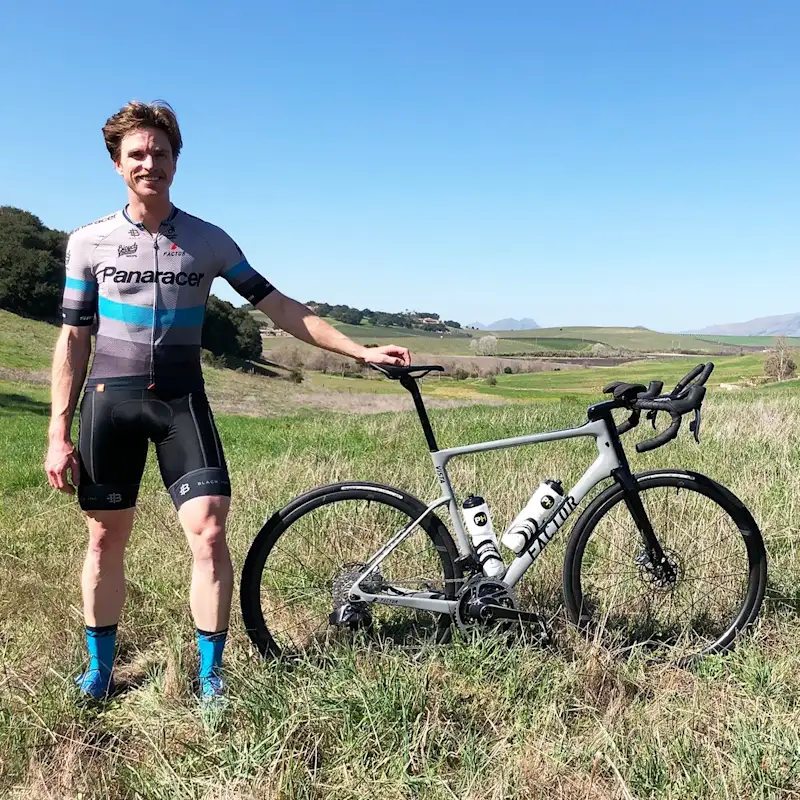
John Borstelmann
Unbound Gravel 200 miler
John's headline numbers
John's strategy
Fueling
Carbohydrate is the main fuel you burn when racing. Failing to fuel properly is a leading cause of underperformance in longer races.
John has undertaken vast amounts of gut training in his training sessions over the past two years to build up from ~65g of carb per hour at the Gravel Worlds in August 2021, to meet and now exceed the carb recommendations of 90g/h for races of this duration and intensity. This aligns with the increasing amount of anecdotal evidence including athlete case studies breaking past the 90g/h ‘barrier’, that’s considered to be the scientific threshold. To achieve these high numbers while riding, over half of John’s fluid intake contained liquid-carbs in the form of PF Carb & Electrolyte Drink Mix, while the rest was predominantly in the form of energy gels, including eight PF 30 Caffeine Gels, which he had in flasks to minimise the effort it took to both open and ingest them.
Hydration
Taking on board an appropriate amount of fluid and sodium is essential to maintaining blood volume and supporting the cardiovascular effort needed to perform on race day.
Whilst the absolute amount of sodium and fluid consumed per hour is important, it’s critical to consider these in relation to each other. This is known as 'relative sodium concentration' and it’s expressed in milligrams per litre (mg/L). How much sodium you’re taking in per litre of fluid is more important than the absolute amount taken in per hour.
Sweat sodium concentration (mg/L) is largely genetically determined and remains relatively stable. Knowing how salty your sweat is enables you to replace a good proportion of your sweat losses, which can range from 200-2,000mg/L.
Given John’s losses are High (1,310mg/L), nailing his hydration strategy becomes especially crucial when it’s hot and/or humid.
Learn moreAveraging just over one litre per hour during the nine-and-a-half hour race, John hit his highest ever fluid intake, which in the hot Kansas conditions will have helped him keep up with his higher than normal sweat rate. Due to the often tricky logistics in gravel racing, John often finds himself pushing the limits of dehydration; this time he felt the opposite, subjectively feeling he was at the top end of what he needed, evidenced by him peeing three times. He also increased his sodium intake to consume a concentration similar to his sweat sodium losses alongside his higher fluid intake. With no hydration-related issues like cramping, which has been a common occurrence for John in past races, coupled with his positive subjective feedback, this was a solid intake which likely replaced a higher proportion of his losses.
Caffeine
Beyond the Three Levers of Performance (carb, sodium and fluid), caffeine is one of only a few substances that is proven to improve performance for most endurance athletes as it can help stave off mental and physical fatigue.
By taking on eight PF 30 Caffeine Gels in addition to a small amount of caffeinated energy drink on race day, John almost doubled the recommended caffeine dosage for his body weight. Luckily, John experienced no negative side effects in doing so, but as no further benefit has been found from such high doses, he may look to bring this down by swapping some of his caffeine gels for standard PF 30 Gels next time out.
How John hit his numbers
Here's everything that John ate and drank on the day...
John's weapons of choice
Final thoughts
John's full stats
Data Confidence?
There is an adequate level of accuracy in the data collected and the numbers reported. The athlete manages to recall what they ate and drank including most specifics (brands flavours quantities plausible estimations of volumes). However there are estimations made within the data which affect the overall confidence level in the data reported.